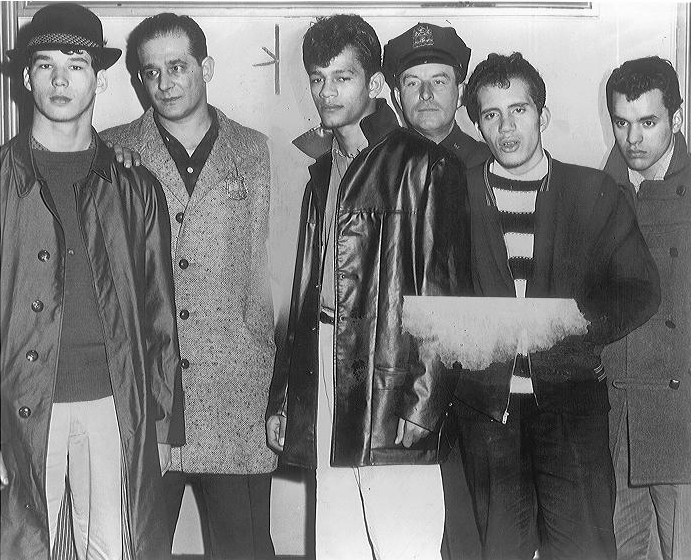Update
Before you get to the article…
On February 23, 2018, my book on the Mau Maus and Sand Street Angels, who were two Brooklyn youth gangs from the 1950s, has been completed. It took 15 years of research and writing to complete Brooklyn Rumble: Mau Maus, Sand Street Angels, and the End of an Era. This book is roughly 6″x9″ and has 370 pages and includes a look at the characters in the Mau Maus and the details of a gang killing that happened in February 1959 in front of the iconic Brooklyn Paramount Theater (now Long Island University). If you want to buy a copy, click here and this link will take you to an online ordering page.
——-
I am currently writing a book on two gangs from Brooklyn in the 1950s: the Mau Maus and Sand Street Angels. Both gangs have long since departed from the neighborhood, but in the 1950s they were both active and dangerous. The book will centre on a killing between these two gangs that took place on a cold winter’s day on February 23, 1959, that happened near the iconic Brooklyn Paramount Theatre (now Long Island University).
The Sand Street Angels were an Italian gang that staked its turf in the Navy Yard section of Brooklyn and had been there since the late 1940s. It was rumoured that the Sand Street Angels had ties to organized crime and it was their hostilities with the Black and Puerto Rican gangs in the area that set up an unavoidable clash that culminated in the death of one of their members.
To the southeast of the Navy Yard was the infamous Fort Greene Projects, a sprawling, massive housing project the City of New York built in World War II to house the workers who toiled away in the construction of warships in the Navy Yard. Unfortunately, as the war ended and the 1940s gave way to the 1950s, the building boom and high employment rate dropped. The lack of jobs and high turnover of families in the Fort Greene Projects did not lend itself to creating a community. Instead, it became a haven for youth gang activity.
By 1957, the Fort Greene Chaplains, a Black gang, and the Mau Maus, a Puerto Rican gang, ruled the projects supreme. Together they protected themselves from the outside enemy and went looking for trouble to protect and advance their name in a never-ending quest to build a “rep,” or a reputation for being a “down” club – the gang vernacular for being bad or tough. With the reputation of the Mau Maus and the Sand Street Angels, the Fort Greene and Navy Yard area had one of the highest juvenile delinquency rates in New York City.
Although the Sand Street Angels and Mau Maus didn’t have troubles with each other at the out-set, it was almost inevitable that they eventually clashed the way they did in 1959. The reasons for this and for the lead-up to the death of Anthony Lavonchino will be explored and dissected in my book.
Anthony Lavonchino was known in the neighbourhood as a tough, swaggering member of the Sand Street Angels. At some point in early 1959, Anthony, under the encouragement and watch of his uncle Genaro Filosa, beat up some kids from the Fort Greene Projects. The Mau Maus, defending their neighbourhood, could not let this stand. So it was, on February 23, 1959, Carl Cintron, Israel Narvaez, Melvin Torres, Carlos Reyes and “Maximo,” avenged the beatings of the boys from their neighbourhood by shooting Anthony in the head and killing him.
Anthony was shot in front of the Brooklyn Paramount theatre sometime around 8:20 p.m., right when theatre-goers were streaming out after their show was completed. Carl Cintron was the one who did the shooting and in short time the police nabbed him and three of the other boys, detaining them all. What happens next will be part of my book as well as what eventually happened to the participants in the killing.

Here is an ad for Alfred Hitchcock’s “Psycho” played at the Paramount Theatre. The Paramount Theatre was well-known for hosting popular shows like Alan Freed’s Rock & Roll Show
My research will not only look at the gang hostilities between the Sand Street Angels and the Mau Maus, but also examine the history of the Navy Yard and Fort Greene Projects, which will hopefully give a glimpse into the youth gang phenomenon that made New York City famous (or infamous) enough that West Side Story still lives with us today.
If you lived in the neighbourhood from this time or knew any of the people involved, feel free to email me at [email protected].


